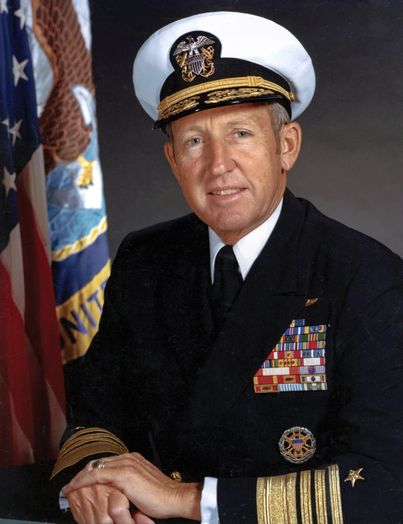
ARLINGTON, Va. — Former chief of naval operations Adm. Thomas B. Hayward died March 3.
CNO Adm. Mike Gilday issued the following statement on Hayward, the 21st CNO:
“Today, the Navy grieves alongside the family and friends of Adm. Thomas B. Hayward as we celebrate his legacy and service to our nation. He was a Sailor, a warfighter, a man of honor and integrity, who served as the chief of naval operations from 1978 to 1982. As CNO, he expertly led the Navy during challenging times after the end of the Vietnam War and the transition to an all-volunteer force. Facing both the 1979 Iranian hostage crisis and renewed Soviet competition in the midst of the Cold War, he rebuilt the combat readiness of the Navy through significant personnel and material investments and restored ‘Pride in the Navy.’ Focused on operational superiority, he prioritized building sophisticated capabilities to support a global, offensive-minded maritime strategy. He enlisted in the Navy during World War II and as a naval aviator flew combat missions in Korea and Vietnam. We truly lost a great leader and shipmate. We are grateful for your leadership, mentorship and commitment to our Navy and nation. Fair winds and following seas, Sir.”
Below is the biography of Hayward:
Hayward was born in Glendale, California, on May 3, 1924, the son of Mr. and Mrs. E. Payson Hayward. A native Californian, Admiral Hayward attended Glendale Junior College and Occidental College at Los Angeles, and in 1943 was appointed a Naval Aviation Cadet in the V-5 Program of the U. S. Naval Reserve. He entered the U.S. Naval Academy in 1944 on appointment from the State of California and upon graduation was commissioned Ensign in the U. S. Navy on June 6, 1947.
Following graduation from the U. S. Naval Academy, he served in the aircraft carrier USS Antietam until detached in September 1948 for flight training at Naval Air Station, Pensacola, Florida. Designated a Naval Aviator on July 26, 1950, he was assigned to Fighter Squadron 51. While with that squadron, he participated in combat operations in Korea, embarked in the carrier USS Essex (CV 9), and later in USS Valley Forge (CVA 45).
In January 1954, he reported for test pilot training at the Naval Air Test Center, Patuxent River, Maryland, and upon completion of training remained there as a test pilot and project coordinator. He next attended the Aviation Safety Officers School at tile University o£ Southern California at Los Angeles, after which he served with All-Weather Fighter Squadron Three. In August 1958 he reported for instruction at the Naval War College, Newport, Rhode Island, and in December 1959, joined Fighter Squadron 211 as executive officer. In July 1961, he became administrative aide to the secretary of the Navy. He was next attached to Fighter Squadron 103 in December 1963, serving as executive officer and later as commanding officer. In July 1965, he assumed command of Attack Carrier Air Wing 10 which was deployed to the Mediterranean aboard the carrier USS Shangri-La (CVA 38), and later to Southeast Asia in the Vietnam conflict aboard the carrier USS Intrepid. (CVS 11).
From August 1966 to August 1967, he was a student at the National War College in Washington, D.C., and in 1967 he received a Master of Science degree in international affairs from George Washington University. He was next commanding officer of the USS Graffias (AF 29) operating off the coast of Vietnam. In August 1968, he reported as executive assistant and aide to the under secretary of the Navy.
In December 1969, he assumed command of the attack carrier USS America (CVA 66), deploying to the 7th Fleet as the flagship of commander Task Force 77. Promoted to rear admiral in November 1970, he reported to Hawaii as commander, Sea Frontier and commandant of the 14th Naval District. He was assigned additional duty as commander Fleet Air, Hawaii, and commander Manned Spacecraft Recovery Forces, Pacific. He became director of the Office of Program Appraisal, Navy Department in December 1971, and on April 26, 1973, was promoted to vice admiral and reported as director, Navy Program Planning in the Office of the Chief of Naval Operations. On June 14, 1975, he assumed command of the U.S. 7th Fleet in the Western Pacific and was embarked in the guided-missile cruiser USS Oklahoma City. Promoted to the rank of admiral, he assumed duties as commander in chief, U. S. Pacific Fleet on August 12, 1976.
Hayward became the 21st chief of naval operations on July 1, 1978 and continued in this assignment until 30 June 1982. He retired from active duty on 1 July 1982.
- Red Sea Update - April 26, 2024
- U.S. Begins Construction on Temporary Pier to Deliver Humanitarian Aid to Gaza - April 26, 2024
- IKE Carrier Strike Group Arrives in the Eastern Mediterranean - April 26, 2024






